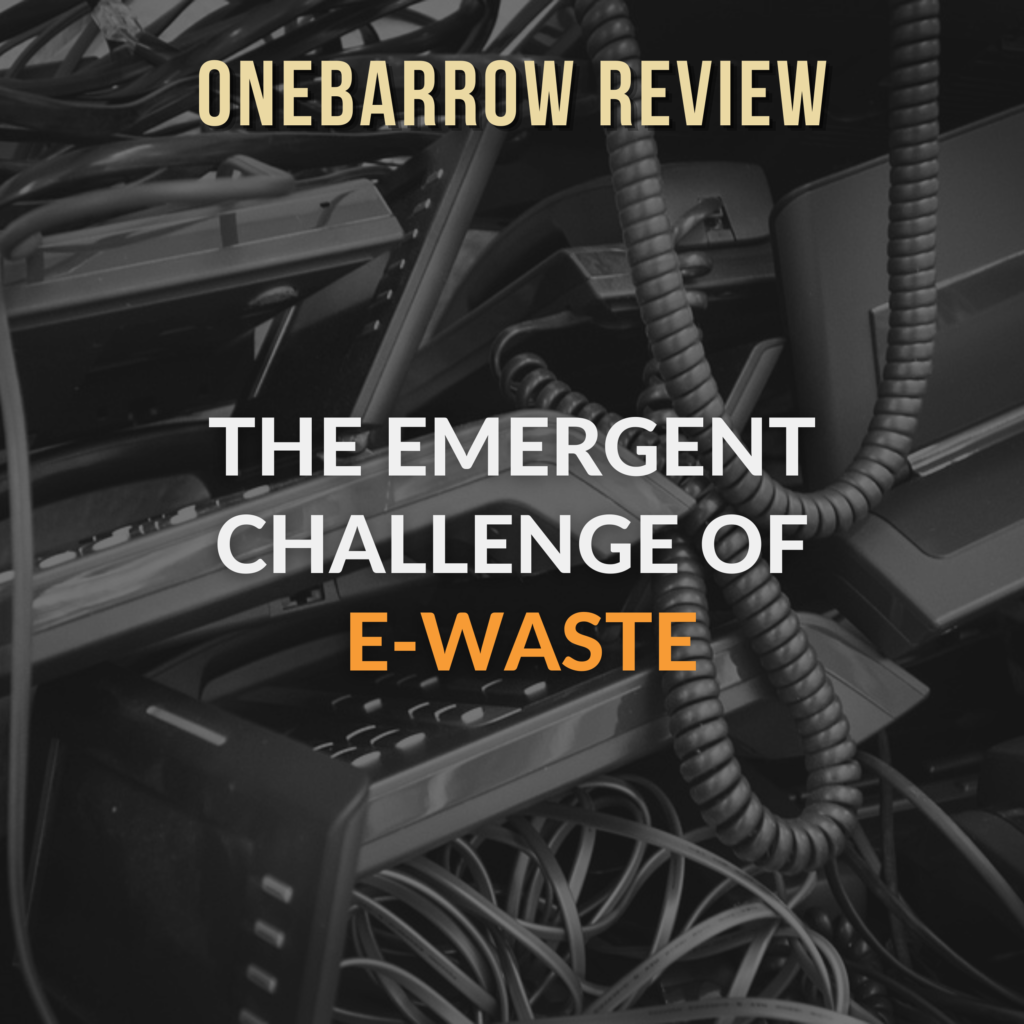The Emergent Challenge of E-Waste
Humans are seemingly adept at adjusting to change – we have found novel vaccines and reimagined workspaces in the short time within which Covid-19 has emerged. Is it fair to say that we always succeed at dynamic adaptations? The case of electronic waste is the face of our recent failure at considering the changing nature of waste production and its management. Have we made a mistake by focusing on plastic waste as the only formidable non-biodegradable waste that we need to tackle? This article explores the complexity of this alarming issue.
What makes e-waste so dangerous?
Electronic waste refers to all electronic equipment like refrigerators, LED screens, cell phones, printers, etc. that are discarded post their usage. E-waste combines the non-biodegradability of plastic components with other, toxic add-ons. Electronic devices consist of chemicals such as lead, mercury, cadmium, barium and arsenic. If e-waste is dumped in landfills, there is often a gradual leakage of these toxins from the discarded devices. These substances then get absorbed into the ground and can contaminate groundwater supply.
E-waste thus needs to be processed in facilities equipped to handle toxic wastes. Does this sort of waste management occur today? The simple answer is no. The more complex answer leads us to evaluate the continued abuses of the Global North against the Global South.
As per the Global E-Waste Statistics Partnership (GESP) only 17.4% of e-waste produced in 2019 was recycled or treated in formal facilities and the rest was shipped from high income to low and medium income nations.
– Global E-Waste Statistics Partnership (GESP)
The Illegal E-Waste Export Industry
The Basel Convention prohibits developed nations from transporting its hazardous wastes (like e-waste) to less developed nations, however the United States has yet to ratify this convention. For profit driven enterprises in the USA, shipping hazardous e-waste overseas is cheaper than properly recycling it within the country itself. This also happens due to the fact that many developing nations do not have legislations against improper e-waste management yet, which makes them easy to exploit.
Interestingly, Western European nations that have signed the Basel Convention have also adopted the strategy of waste shipping towards lower and middle income nations. As per the Interpol, manufacturers in developed countries label hazardous e-waste as ‘used goods’ to illegally export it to Asia and Africa. Basel Action Network (BAN) is a leading environmental watchdog that made the discovery that the UK was the top offender for exporting its e-waste, among European nations. Denmark, Germany and Italy are not far behind. As the BAN data shows, much of the UK’s toxic e-waste ends up in Ghana, Nigeria, Pakistan and Tanzania. Annually, more than 350,000 metric tonnes of e-waste is illegally shipped out of Europe.
What becomes of E-waste when it reaches its destination?
Apart from the toxins previously highlighted, devices contain small amounts of precious metals like gold. In countries like Ghana, India, Nigeria and Vietnam, there has emerged an informal industry that employs people to sift through the waste, reprocess some materials from the devices and look for valuable parts. Dismantling corroding machines has a negative impact on the health of workers, yet there is no provision of equipment like gloves and face masks. Workers are not given clear information on the dangerous waste that they are made to deal with. Direct inhalation of toxic fumes and exposure to harmful substances is increasingly common.
Are workers in the informal sector the only vulnerable targets? As per the WHO report released in June, 2021 entitled ‘Children and Digital Dumpsites’, exposure of child workers and pregnant women to e-waste is jeopardizing the healthy future of scores of West African and South Asian children. More than 18 million children and adolescents are directly or indirectly exposed to e-waste while performing their jobs in the informal sector. Small children are considered better at tasks like finding small bits of precious metals from waste due to their nimble fingers, which leads to greater employment of children in the e-waste industry.
There are numerous health risks associated with exposure to toxic e-waste like liver and kidney damage, neurological disorders and cancers. Children are relatively more vulnerable to these health risks. Additionally, as per the WHO, exposure to lead can damage a child’s normal intellectual development.
“A child who eats just one chicken egg from Agbogbloshie [the world’s largest e-waste dump site], in Ghana, will absorb 220 times the European Food Safety Authority daily limit for intake of chlorinated dioxins.”
– Marie-Noel Brune Drisse, lead WHO author on the Children and Digital Dumpsites Report, June 2021.
The Way Forward
Some major corporate giants can be commended for their commitment to recycling and e-waste reduction. Intel has continued to successfully recycle more than 75% of its total waste each year since 2008. Intel’s CSR policy has shown dedication towards working to develop a circular economy where maximum utilization of used parts can take place by means of recycling or refurbishing. According to its 2020-21 Corporate Responsibility Report, Intel reuses 50-60% of its returned products. Electronic components that cannot be reused or resold are routed through Intel’s network of recycling vendors, with over 99% of materials reclaimed for precious metals or recycled. This also indicates that with the right partnerships and policies this issue is not one that we cannot tackle.
It’s vital for corporations to convey their CSR and waste disposal policies to consumers to have a transparent and trust filled relationship with them. Corporations can make substantial contributions towards creating opportunities to educate households, employees and their customers on right recycling practices that ensure that e-waste reaches the right processing facilities. Another important aspect of reducing waste generation is to tie up with third parties that can refurbish equipment for reuse. It’s more important for businesses to commit to building appliances that last longer and are easy to repair, than to perpetuate a highly consumerist cycle of encouraging buyers to purchase new models of the same goods every few months.
Sustainable Development Goal 12 calls for us to ‘ensure sustainable consumption and production patterns’. Keeping this in mind, recycling e-waste is a simple solution that can help reduce the carbon footprint of businesses while ensuring that tonnes of toxic material does not harm people, the environment and our natural resources.
While the facts in this instance are sobering, we at OneBarrow do not believe that dejection is the response to the problems our civilization faces. There is a capacity for positive innovations at each step of human development. CSR partnerships with organizations like ours can enable businesses to engage with communities to raise awareness and analyze policies to ensure that they do not have adverse outcomes for the planet or its people. When it comes to the planet’s wellbeing, no individual or collective act is too small to make an impact.
– Riya Shankar Sharma
Content Writer, OneBarrow
***********
References:
- Forti V., Baldé C.P., Kuehr R., Bel G. The Global E-waste Monitor 2020: Quantities, flows and the circular economy potential. United Nations University (UNU)/United Nations Institute for Training and Research (UNITAR) – co-hosted SCYCLE Programme, International Telecommunication Union (ITU) & International Solid Waste Association (ISWA), Bonn/Geneva/Rotterdam.
Retrieved from: https://www.itu.int/en/ITU-D/Environment/Documents/Toolbox/GEM_2020_def.pdf
- Vidal, J. , Toxic E-Waste Dumped in Poor Nations, Says United Nations. Our World, United Nations University. 2013, December 16.
Retrieved from: https://ourworld.unu.edu/en/toxic-e-waste-dumped-in-poor-nations-says-united-nations
- Interpol. Electronic Waste And Organized Crime, Assessing The Links. May 2009, Michigan State University, USA. Untitled.
Retrieved From: https://www.interpol.int/content/download/5174/file/Electronic%20Waste%20and%20Organized%20Crime%20-%20Assessing%20the%20Links.pdf.
- Children and digital dumpsites: e-waste exposure and child health. Geneva: World Health Organization; 2021. Licence: CC BY-NC-SA 3.0 IGO.
Retrieved from: https://www.who.int/publications/i/item/9789240023901
- Intel, “2020-21 Corporate Responsibility Report.” Intel Corporate Social Responsibility. 2021.
Retrieved from: http://csrreportbuilder.intel.com/pdfbuilder/pdfs/CSR-2020-21-Full-Report.pdf
- Laville, S. “UK worst offender in Europe for electronic waste exports – report.” The Guardian. 7 February, 2019.
Retrieved from: https://www.theguardian.com/environment/2019/feb/07/uk-worst-offender-in-europe-for-electronic-waste-exports-report

















